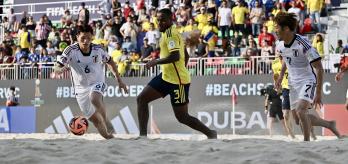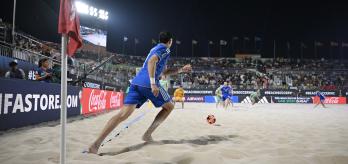Despite teams making a total of 208 attempts at goal from corners at the FIFA Beach Soccer World Cup 2024™, only eight goals were scored in this game phase.
Tahiti (26) and Brazil (25) generated the most attempts at goal from corners, while Portugal were the only team to convert more than one attempt from a corner during this tournament. Semi-finalists Belarus were one of only seven teams to score from a corner, despite creating just five attempts at goal from these dead-ball situations.
Man-marking and counter-attack fears
Dejan Stankovic believes defensive acumen and a fear of counter-attacks may explain the low number of goals scored from this type of set play. “I think the reason why teams are finding it so difficult to score from corners is because of the quality of man-marking that is taking place. Attacking players are so tightly marked that it is difficult to create space or even to make movements that get you free from your marker.
“In addition to this, some teams opted to play back to their goalkeeper from the corner and tried to build attacks that way, rather than putting the ball directly into the attacking zone and risk being caught on the counter-attack. This development is not positive and will force teams to come up with new solutions for attacking corners and to generate new ways of scoring from them.”
Attacking the near post
Despite so few goals being scored from corners, our Technical Study Group (TSG) noted some innovative routines used by teams that were attempting to attack the near-post area. In the clips below, TSG member Matteo Marrucci identifies some of the different attacking approaches used throughout the tournament, as well as the different defensive set-ups these approaches were used against.
Near-post runs using decoys versus man-marking set-up
In clip 1 below, Portugal’s three attacking players are man-marked by Oman, who position their spare defender at the near post. Portugal use their player that starts closest to the near post, Miguel Pintado (9), as a decoy runner to drag his man-marking defender away from this area. Pintado’s run creates space for Leo Martins (11) to then run to the near post and score the game’s deciding goal.
In clip 2, Spain are man-marking Tahiti in a 3v3 while opting to use their spare outfield player as an attacking option in the event of an attacking transition. Tahiti use a two-player rotation comprised of Tamatoa Tetauira (3) and Teaonui Tehau (11) to release a runner at the near post, generating a headed attempt at goal.
Near-post run versus zonal set-up
In this clip, Colombia have a set-up comprising of three zonal players and one marker. Senegal double up on the man-marker. Papa Ndoye (3), one of the players doubling up on the marker, runs untracked from behind his marked team-mate into the near-post space between the zonal players and scores with a right-footed finish.
Near-post attack using blocks and decoy runs
In clip 4, Belarus utilise a two-man attacking rotation with blocks against Japan’s hybrid marking set-up. Aleh Hapon (5) blocks the marker tracking Anatoliy Ryabko’s (10) run. However, Ryabko’s run, which attracts one of Japan’s zonal players away from their zone, is merely a decoy. Exploiting the confusion, Hapon quickly moves in front of his own marker to receive the first pass and generate an attempt at goal.
In clip 5, Spain also use blocks and decoy runs to generate an attempt at goal from the near-post area. Tahiti are set up man-to-man against Spain’s three designated attacking players, with their spare defender manning the near post. The two Spanish players closest to the goal make runs away from the area. At the same time, back-post player Chiky (11) attempts a block on the marker tracking Spain’s attacker starting furthest from goal, David Ardil (5), who is making the near-post run. As the ball is delivered, Chiky also gets free at the far post, meaning Spain have players open to attack the ball at both posts.
Taking the corner quickly to attack the near post
Against Oman, Portugal initiate their attacking corner routine before either team is set. As soon as they win the corner, following a high, individual press by Martins, Portugal decide to take their corner quickly. With Jordan (5) running up to the attack towards the back-post area, he suddenly changes direction towards the near post, losing the nearest defender in the process. He uses the bicycle technique and scores with his first touch.
The attacking train
In this clip, Brazil position their three attacking players in a “train” away from the goal and in line with the back post. Mexico man-mark all three players and keep their spare player in the space ahead of the near post. Brazil’s Alisson (3), who is the player in the train closest to Mexico’s goal, makes a near-post run, connecting with the delivery to create an attempt at goal.
Summary
With just eight goals scored from attacking corners during FIFA Beach Soccer World Cup 2024, it was obvious that scoring goals from these situations is becoming increasingly difficult at the highest level. With so few goals registered, it was not possible to pinpoint any particular trend in the attacking corner phase. However, some of the attacking routines used by teams when targeting the near post were creative.
Player rotations, decoy movements and blocks were all used in various ways with each team developing their own attacking corner routines. We selected examples of these against different defensive systems (man-marking, zonal and hybrid) for educational and inspirational purposes.



















